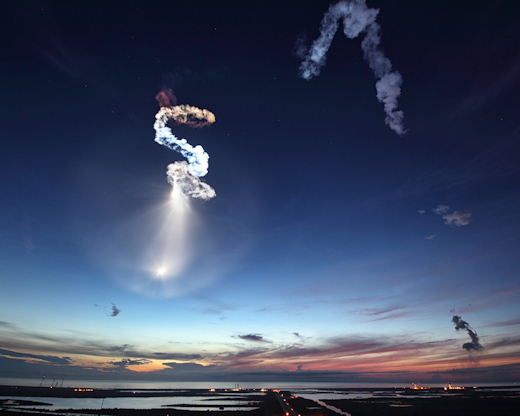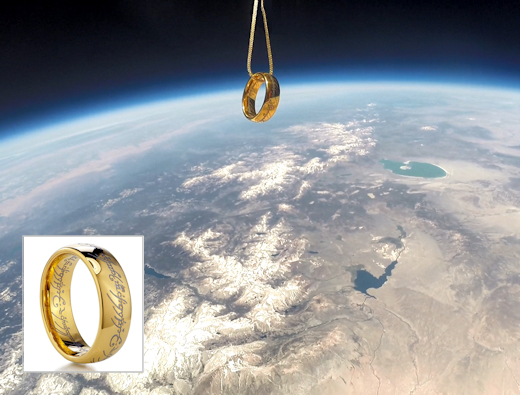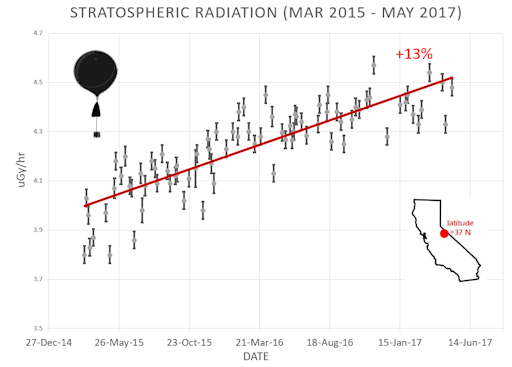All-inclusive Northern Lights trips in Tromsø, Norway. Small groups, big experiences! Highly qualified guides ensure unique and unforgettable adventures with a personal touch. Visit Explore the Arctic | | |
MOON-MARS CONJUNCTION: Tonight, around midnight, step outside and look southeast. The waning gibbous Moon is passing by Mars, forming a heavenly duo in the constellation Capricornus. Note the color of Mars. It is the pale orange hue of a great dust storm now encircling the Red Planet. Sky maps: June 29, 30.
RADIO SIGNALS FROM THE NOCTILUCENT ZONE: High above the Arctic Circle in Lofoten, Norway, researcher Rob Stammes cannot see noctilucent clouds through the glare of the midnight sun. He has a different way of experiencing them. He listens. "On June 26th, my VHF radio system recorded polar mesospheric summertime echoes (PMSEs)--a sign of noctilucent cloud activity," he explains.

PMSEs are the sounds of terrestrial radio stations, beaming up from Earth, then reflected back to the ground from an altitude of 80 km to 90 km. That part of Earth's upper atmosphere is the mesosphere, the same place noctilucent clouds are found. The exact cause of PMSEs is not yet known; theorists have proposed explanations ranging from steep electron density gradients and "dressed aerosols" to gravity waves and turbulence. The echoes are often accompanied by visible NLCs at lower altitudes where darkness allows the clouds to be seen.
"I have detected very strong Polar Mesospheric Summer Echoes on several occasions this season," says Stammes. "The radio stations are in eastern Europe. I am carefully monitoring the NLC Photo Gallery to study the relationship between the clouds and these strange radio reflections."
He detected
another episode of radio echoes on June 16th--confirming what is now obvious to the naked eye for many northern sky watchers: NLC season is finally underway. Stay tuned for more PMSEs.
Realtime Space Weather Photo Gallery
SPACEX MAKES A NOCTILUCENT CLOUD: NASA's AIM spacecraft is monitoring a veritable explosion of natural noctilucent clouds (NLCs) around the Arctic Circle. Yesterday, June 29th, SpaceX created an NLC of its own by launching a rocket over Florida. Mike Deep photographed the jellyfish-shaped cloud from the roof of the Vehicle Assembly Building at Kennedy Space Center:

"SpaceX launched a Falcon 9 rocket carrying supplies to the ISS," explains Deep. "The liftoff time was pre-dawn at 5:42am, which meant the rocket lifted off in darkness and ascended into sunlight at extreme altitude, resulting in noctilucent clouds and a jellyfish plume from the second stage."
Natural noctilucent clouds form when summertime wisps of water vapor rise to the top of Earth's atmosphere and crystallize around specks of meteor smoke. Mesospheric winds gather the resulting ice crystals into rippling clouds of electric-blue around the Arctic Circle.
Manmade noctilucent clouds, on the other hand, can form from ice crystals in a rocket's exhaust. These crystals can catch the rays of the distant rising sun, producing luminous forms in the dark pre-dawn sky. Sample photos may be found here, here and here.
SpaceX's noctilucent cloud was fleeting. It's gone now. But the natural variety may still be seen from high-latitude locations in Europe and Canada. Observing tips: Look west 30 to 60 minutes after sunset when the sun has dipped well below the horizon. If you see luminous blue-white tendrils spreading across the sky, you may have spotted a noctilucent cloud.
Realtime Noctilucent Cloud Photo Gallery
ONE RING TO RULE THE STRATOSPHERE: This week, the students of Earth to Sky Calculus are in New Zealand launching cosmic ray balloons over Earth's 8th continent. To pay for the helium, they launched a ring of power to the stratosphere. Here it is floating 33 km above the Sierra Nevada mountains of central California:

You can have one for $119.95. The students are selling these rings as a fundraiser for their trip. They are made of golden-colored tungsten and inscribed with the authentic Mordor script of the One Ring.
Buy one now, and we will fly it again for you over Hobbiton, located in the North Island of New Zealand where our cosmic ray balloons will be released. Just note "Please fly it again!" in the comments section at checkout.
Each golden ring comes with a greeting card showing the ring in flight and telling the story of its journey to the edge of space. Sales support the Earth to Sky Calculus cosmic ray ballooning program and hands-on STEM research.
Far Out Gifts: Earth to Sky Store
All proceeds support hands-on STEM education
Realtime Aurora Photo Gallery
Every night, a network of
NASA all-sky cameras scans the skies above the United States for meteoritic fireballs. Automated software maintained by NASA's Meteoroid Environment Office calculates their orbits, velocity, penetration depth in Earth's atmosphere and many other characteristics. Daily results are presented here on Spaceweather.com.
On Jun. 30, 2018, the network reported 15 fireballs.
(15 sporadics)

In this diagram of the inner solar system, all of the fireball orbits intersect at a single point--Earth. The orbits are color-coded by velocity, from slow (red) to fast (blue). [Larger image] [movies]
Potentially Hazardous Asteroids (
PHAs) are space rocks larger than approximately 100m that can come closer to Earth than 0.05 AU. None of the known PHAs is on a collision course with our planet, although astronomers are finding
new ones all the time.
On June 30, 2018 there were 1912 potentially hazardous asteroids.
 |
Recent & Upcoming Earth-asteroid encounters: | Asteroid | Date(UT) | Miss Distance | Velocity (km/s) | Diameter (m) |
| 2018 MX4 | 2018-Jun-27 | 5.5 LD | 8 | 15 |
| 2018 LN2 | 2018-Jun-28 | 10.5 LD | 9.4 | 87 |
| 2018 MH7 | 2018-Jun-28 | 11.4 LD | 4.4 | 20 |
| 2018 LR3 | 2018-Jun-29 | 6 LD | 3.8 | 20 |
| 2018 LT6 | 2018-Jul-01 | 11.6 LD | 12.9 | 126 |
| 2018 LJ1 | 2018-Jul-01 | 13.9 LD | 2.7 | 18 |
| 2018 MB7 | 2018-Jul-04 | 2.8 LD | 11.6 | 64 |
| 2018 LQ2 | 2018-Aug-27 | 9.4 LD | 1.5 | 41 |
| 2016 GK135 | 2018-Aug-28 | 16.8 LD | 2.8 | 9 |
Notes: LD means "Lunar Distance." 1 LD = 384,401 km, the distance between Earth and the Moon. 1 LD also equals 0.00256 AU. MAG is the visual magnitude of the asteroid on the date of closest approach. | | Cosmic Rays in the Atmosphere |
Readers, thank you for your patience while we continue to develop this new section of Spaceweather.com. We've been working to streamline our data reduction, allowing us to post results from balloon flights much more rapidly, and we have developed a new data product, shown here:

This plot displays radiation measurements not only in the stratosphere, but also at aviation altitudes. Dose rates are expessed as multiples of sea level. For instance, we see that boarding a plane that flies at 25,000 feet exposes passengers to dose rates ~10x higher than sea level. At 40,000 feet, the multiplier is closer to 50x. These measurements are made by our usual cosmic ray payload as it passes through aviation altitudes en route to the stratosphere over California.
What is this all about? Approximately once a week, Spaceweather.com and the students of Earth to Sky Calculus fly space weather balloons to the stratosphere over California. These balloons are equipped with radiation sensors that detect cosmic rays, a surprisingly "down to Earth" form of space weather. Cosmic rays can seed clouds, trigger lightning, and penetrate commercial airplanes. Furthermore, there are studies ( #1, #2, #3, #4) linking cosmic rays with cardiac arrhythmias and sudden cardiac death in the general population. Our latest measurements show that cosmic rays are intensifying, with an increase of more than 13% since 2015:

Why are cosmic rays intensifying? The main reason is the sun. Solar storm clouds such as coronal mass ejections (CMEs) sweep aside cosmic rays when they pass by Earth. During Solar Maximum, CMEs are abundant and cosmic rays are held at bay. Now, however, the solar cycle is swinging toward Solar Minimum, allowing cosmic rays to return. Another reason could be the weakening of Earth's magnetic field, which helps protect us from deep-space radiation.
The radiation sensors onboard our helium balloons detect X-rays and gamma-rays in the energy range 10 keV to 20 MeV. These energies span the range of medical X-ray machines and airport security scanners.
The data points in the graph above correspond to the peak of the Reneger-Pfotzer maximum, which lies about 67,000 feet above central California. When cosmic rays crash into Earth's atmosphere, they produce a spray of secondary particles that is most intense at the entrance to the stratosphere. Physicists Eric Reneger and Georg Pfotzer discovered the maximum using balloons in the 1930s and it is what we are measuring today.
| | The official U.S. government space weather bureau |
| | The first place to look for information about sundogs, pillars, rainbows and related phenomena. |
| | Researchers call it a "Hubble for the sun." SDO is the most advanced solar observatory ever. |
| | 3D views of the sun from NASA's Solar and Terrestrial Relations Observatory |
| | Realtime and archival images of the Sun from SOHO. |
| | from the NOAA Space Environment Center |
| | fun to read, but should be taken with a grain of salt! Forecasts looking ahead more than a few days are often wrong. |
| | from the NOAA Space Environment Center |
| | the underlying science of space weather |
 | Reviews here can help you to pick up best memory foam mattresses. |
| | These links help Spaceweather.com stay online. Thank you to our supporters! |
| | | | | | |

